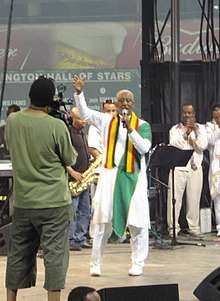Mahmoud Ahmed
Mahmoud Ahmed (Amharic: ማሀሙድ አህመድ; born May 8 or 18, 1941)[1][2] is an Ethiopian singer of Gurage ancestry.[3] He gained great popularity in Ethiopia in the 1970s and among the Ethiopian diaspora in the 1980s, before rising to international fame with African music fans in Europe and the Americas.
Mahmoud Ahmed ማሐሙድ አህመድ | |
|---|---|
 Mahmoud Ahmed performing in 2005 | |
| Background information | |
| Born | May 1941 (age 79) Addis Ababa, Ethiopia |
| Origin | Gurage, Ethiopia |
| Instruments | Vocals |
| Associated acts |
|
Biography
Born in Addis Ababa, Mercato district,[4] Mahmoud was enthralled with the music he heard on Ethiopian radio from an early age. Having poorly learned in school, he worked shoeshiner before becoming a handyman at the Arizona Club, which was the after hours hangout of Emperor Haile Selassie I's Imperial Bodyguard Band.[4][5] One night in 1962 when the band's singer didn't show up, Mahmoud asked to sing a few songs.[4] He soon became part of the band's regular lineup, where he remained until 1974.[1]
After cutting his first single with Venus Band "Nafqot New Yegodagn" and "Yasdestal" in 1971, Mahmoud continued to record with several bands for the Amha and Kaifa record labels throughout the 1970s. The overthrow of Emperor Selassie and the suspension of musical nightlife under the military government created shifts in the Ethiopian music industry—the Imperial Body Guard Band were no more, and Mahmoud continued to make hit records and cassettes with many musicians who remained in the country, including the Dahlak Band, and the Ibex Band. He also began to release solo cassettes, accompanying himself on the krar, guitar or mandolin.

By 1978, censorship laws prevented Mahmoud from releasing his music on vinyl and so he switched to releasing cassettes. In the 1980s, Mahmoud operated his own music store in Addis Ababa's Piazza district while continuing his singing career. With many Ethiopian refugees living abroad, Mahmoud became one of the first modern Ethiopian music makers to perform in the United States on a 1980–1981 tour with the Walias Band, Getatchew Kassa, and Webeshet Fisseha. Mahmoud soon began releasing records with the Roha Band and became popular in diaspora communities.[3]
In 1986, Mahmoud's music reached a larger western audience when the Belgian label Crammed Discs released the collection Ere Mela Mela drawn from two Kaifa LPs Mahmoud had recorded in Addis with the Ibex Band a decade earlier.[3][6] Ethiopia was making headlines in the west because of political repression and famine, and the contrasting tone of Mahmoud's first international release received much acclaim in the burgeoning world music community. Mahmoud gained even greater international popularity in the late 1990s after Buda Musique launched the Éthiopiques series on compact disc. This led to new recordings and tours in Europe and the United States with Boston's Either/Orchestra and Badume Band. Though he has made his home in Addis Ababa and works with a number of NGOs and philanthropic causes,[7] he continues to tour internationally, performing concerts both for world music fans as well as the Ethiopian diaspora.[3]
In 2007, Mahmoud won a BBC World Music Award.[8]
While Ere Mela Mela made him a household name, Mahmoud is generally known for his Tizita, a genre that reminisce the past – slow and groovy style of music, Tew Lemed Gelaye with close to three million views on You Tube is one of his enduring Tizita music of the modern era.
Discography
- Almaz with Ibex Band (1973 LP; reissued on CD in 1999 as Éthiopiques Volume 6 by Buda Musique)
- Alemye (1974 LP, reissued on CD in 2005 as Éthiopiques Volume 19 by Buda Musique)
- Ere Mela Mela (1975 LP, rereleased on Crammed Discs in 1986 with extra tracks, remixed, expanded and reissued on CD in 2000 as Etiopiques Volume 7 by Buda Musique)
- Soul of Addis (1997, Earthworks/Stern's Africa)
- Slow Collections (1998, Sounds of Abyssinia)
- Live in Paris (1998, Long Distance)
- Yitbarek (2003, Yene Production, rereleased by Nahom Records in 2007)
- Tizita Vol. 1 (The Best of...) (2003, AIT Records)
- Tizita Vol. 2 (The Best of...) (2003, AIT Records)
- The Rough Guide to the Music of Ethiopia (2004, World Music Network)
- Ethiogroove: Mahmoud Ahmed & Either/Orchestra, with Tsedenia G. Markos (2007, EthioSonic DVD)
- Éthiopiques Live: Mahmoud Ahmed, Alemayehu Eshete & Badume's Band (2009, Innacor DVD)
- Éthiopiques 26: Mahmoud Ahmed & Imperial Bodyguard Band, 1972–1974 (collects music from singles released on the Philips label)
- The Rough Guide to the Music of Ethiopia (2012, World Music Network)
References
- Cartwright, Garth (2007). "Awards for World Music 2007 – Mahmoud Ahmed". BBC Radio 3. Retrieved May 8, 2019.
- Mahmoud Ahmed at AllMusic
- Eyre, Banning. "Mahmoud Ahmed". National Geographic World Music. Afropop Worldwide. Archived from the original on June 10, 2008. Retrieved February 22, 2013.
- Falceto, Francis (1999). Almaz 1973 (Media notes). Éthiopiques. Mahmoud Ahmed. Buda Musique. 829792.
- Soul of Addis (Media notes). Mahmoud Ahmed. Earthworks/Stern's. 1997. STEW35CD.CS1 maint: others (link)
- Prosaïc, Anaïs (1999). Ere Mela Mela 1975 (Media notes). Éthiopiques. Mahmoud Ahmed. Buda Musique. pp. 15–16. 829802.
- http://www.tadias.com/11/29/2008/mahamud-ahmed-at-benefit-concert-to-build-ethiopian-church-in-san-diego/
- "BBC Awards for World Music: Mahmoud Ahmed". BBC. Retrieved November 13, 2011.
Further reading
- Jonathan Miran, "Mahmoud Ahmed," Dictionary of African Biography, Eds. Henry Louis Gates, Jr. and Emmanuel K. Akyeampong (New York: Oxford University Press, 2012), Volume 4, pp. 43–44.
External links
- Interview with Mahmoud Ahmed on Fly Global Music Culture at the Wayback Machine (archived December 23, 2005)
- Discography of Mahmoud Ahmed as provided by Discogs